Has the WTO Effectively Managed Dumping and Subsidies by China?
VerifiedAdded on 2023/01/04
|6
|2111
|70
Essay
AI Summary
This essay critically analyzes the World Trade Organization's (WTO) effectiveness in addressing instances of dumping and subsidies, particularly focusing on the practices of larger nations like China. The essay begins by defining dumping and subsidies, outlining the WTO's agreements and policies designed to combat these practices. It then evaluates the WTO's success in implementing these policies, arguing that the organization has not been successful in controlling dumping and subsidies. The essay presents several reasons for this failure, including the WTO's passive role, the ambiguity in its anti-dumping rules, the creation of economic and political tensions, and the increasing number of disputes related to dumping activities. The analysis concludes that the WTO's current approach, which primarily allows governments to take action after harm has been proven, is insufficient. The essay suggests that stricter laws and a more proactive approach are needed to effectively control dumping and subsidies, protecting domestic markets and fostering fair trade practices. The essay uses the OSCOLA referencing style and adheres to the word count guidelines provided in the assignment brief.

Title page
Paraphrase This Document
Need a fresh take? Get an instant paraphrase of this document with our AI Paraphraser
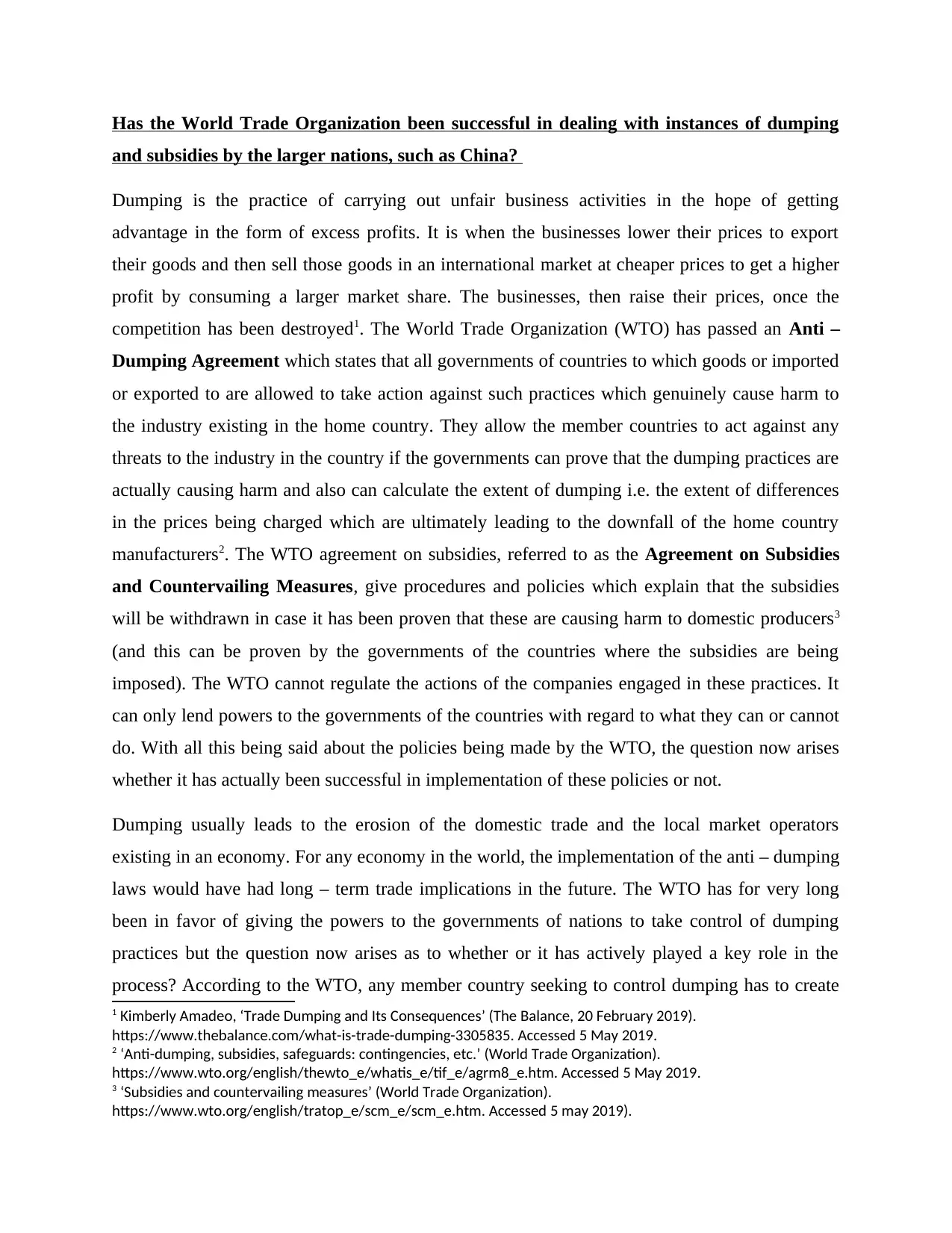
Has the World Trade Organization been successful in dealing with instances of dumping
and subsidies by the larger nations, such as China?
Dumping is the practice of carrying out unfair business activities in the hope of getting
advantage in the form of excess profits. It is when the businesses lower their prices to export
their goods and then sell those goods in an international market at cheaper prices to get a higher
profit by consuming a larger market share. The businesses, then raise their prices, once the
competition has been destroyed1. The World Trade Organization (WTO) has passed an Anti –
Dumping Agreement which states that all governments of countries to which goods or imported
or exported to are allowed to take action against such practices which genuinely cause harm to
the industry existing in the home country. They allow the member countries to act against any
threats to the industry in the country if the governments can prove that the dumping practices are
actually causing harm and also can calculate the extent of dumping i.e. the extent of differences
in the prices being charged which are ultimately leading to the downfall of the home country
manufacturers2. The WTO agreement on subsidies, referred to as the Agreement on Subsidies
and Countervailing Measures, give procedures and policies which explain that the subsidies
will be withdrawn in case it has been proven that these are causing harm to domestic producers3
(and this can be proven by the governments of the countries where the subsidies are being
imposed). The WTO cannot regulate the actions of the companies engaged in these practices. It
can only lend powers to the governments of the countries with regard to what they can or cannot
do. With all this being said about the policies being made by the WTO, the question now arises
whether it has actually been successful in implementation of these policies or not.
Dumping usually leads to the erosion of the domestic trade and the local market operators
existing in an economy. For any economy in the world, the implementation of the anti – dumping
laws would have had long – term trade implications in the future. The WTO has for very long
been in favor of giving the powers to the governments of nations to take control of dumping
practices but the question now arises as to whether or it has actively played a key role in the
process? According to the WTO, any member country seeking to control dumping has to create
1 Kimberly Amadeo, ‘Trade Dumping and Its Consequences’ (The Balance, 20 February 2019).
https://www.thebalance.com/what-is-trade-dumping-3305835. Accessed 5 May 2019.
2 ‘Anti-dumping, subsidies, safeguards: contingencies, etc.’ (World Trade Organization).
https://www.wto.org/english/thewto_e/whatis_e/tif_e/agrm8_e.htm. Accessed 5 May 2019.
3 ‘Subsidies and countervailing measures’ (World Trade Organization).
https://www.wto.org/english/tratop_e/scm_e/scm_e.htm. Accessed 5 may 2019).
and subsidies by the larger nations, such as China?
Dumping is the practice of carrying out unfair business activities in the hope of getting
advantage in the form of excess profits. It is when the businesses lower their prices to export
their goods and then sell those goods in an international market at cheaper prices to get a higher
profit by consuming a larger market share. The businesses, then raise their prices, once the
competition has been destroyed1. The World Trade Organization (WTO) has passed an Anti –
Dumping Agreement which states that all governments of countries to which goods or imported
or exported to are allowed to take action against such practices which genuinely cause harm to
the industry existing in the home country. They allow the member countries to act against any
threats to the industry in the country if the governments can prove that the dumping practices are
actually causing harm and also can calculate the extent of dumping i.e. the extent of differences
in the prices being charged which are ultimately leading to the downfall of the home country
manufacturers2. The WTO agreement on subsidies, referred to as the Agreement on Subsidies
and Countervailing Measures, give procedures and policies which explain that the subsidies
will be withdrawn in case it has been proven that these are causing harm to domestic producers3
(and this can be proven by the governments of the countries where the subsidies are being
imposed). The WTO cannot regulate the actions of the companies engaged in these practices. It
can only lend powers to the governments of the countries with regard to what they can or cannot
do. With all this being said about the policies being made by the WTO, the question now arises
whether it has actually been successful in implementation of these policies or not.
Dumping usually leads to the erosion of the domestic trade and the local market operators
existing in an economy. For any economy in the world, the implementation of the anti – dumping
laws would have had long – term trade implications in the future. The WTO has for very long
been in favor of giving the powers to the governments of nations to take control of dumping
practices but the question now arises as to whether or it has actively played a key role in the
process? According to the WTO, any member country seeking to control dumping has to create
1 Kimberly Amadeo, ‘Trade Dumping and Its Consequences’ (The Balance, 20 February 2019).
https://www.thebalance.com/what-is-trade-dumping-3305835. Accessed 5 May 2019.
2 ‘Anti-dumping, subsidies, safeguards: contingencies, etc.’ (World Trade Organization).
https://www.wto.org/english/thewto_e/whatis_e/tif_e/agrm8_e.htm. Accessed 5 May 2019.
3 ‘Subsidies and countervailing measures’ (World Trade Organization).
https://www.wto.org/english/tratop_e/scm_e/scm_e.htm. Accessed 5 may 2019).
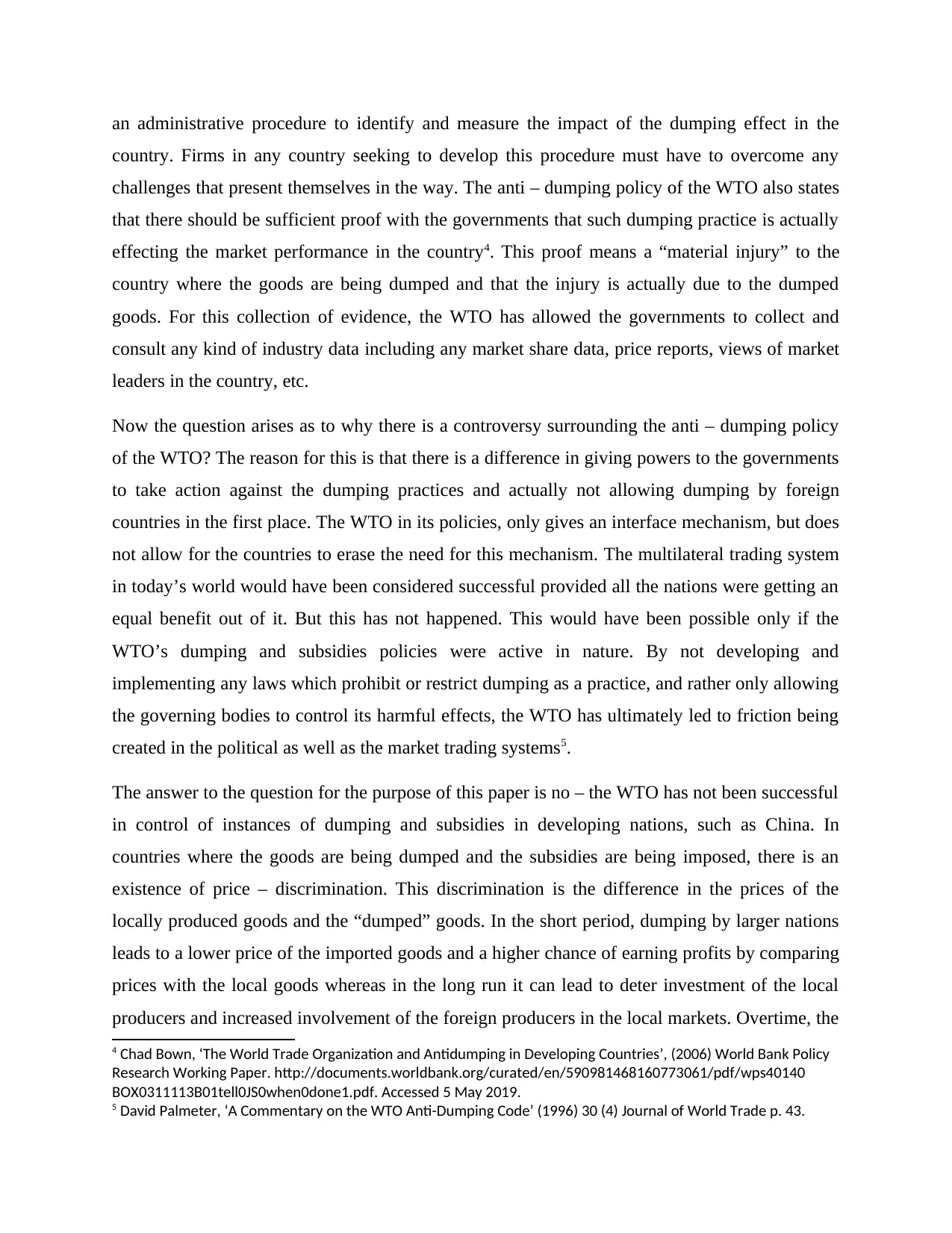
an administrative procedure to identify and measure the impact of the dumping effect in the
country. Firms in any country seeking to develop this procedure must have to overcome any
challenges that present themselves in the way. The anti – dumping policy of the WTO also states
that there should be sufficient proof with the governments that such dumping practice is actually
effecting the market performance in the country4. This proof means a “material injury” to the
country where the goods are being dumped and that the injury is actually due to the dumped
goods. For this collection of evidence, the WTO has allowed the governments to collect and
consult any kind of industry data including any market share data, price reports, views of market
leaders in the country, etc.
Now the question arises as to why there is a controversy surrounding the anti – dumping policy
of the WTO? The reason for this is that there is a difference in giving powers to the governments
to take action against the dumping practices and actually not allowing dumping by foreign
countries in the first place. The WTO in its policies, only gives an interface mechanism, but does
not allow for the countries to erase the need for this mechanism. The multilateral trading system
in today’s world would have been considered successful provided all the nations were getting an
equal benefit out of it. But this has not happened. This would have been possible only if the
WTO’s dumping and subsidies policies were active in nature. By not developing and
implementing any laws which prohibit or restrict dumping as a practice, and rather only allowing
the governing bodies to control its harmful effects, the WTO has ultimately led to friction being
created in the political as well as the market trading systems5.
The answer to the question for the purpose of this paper is no – the WTO has not been successful
in control of instances of dumping and subsidies in developing nations, such as China. In
countries where the goods are being dumped and the subsidies are being imposed, there is an
existence of price – discrimination. This discrimination is the difference in the prices of the
locally produced goods and the “dumped” goods. In the short period, dumping by larger nations
leads to a lower price of the imported goods and a higher chance of earning profits by comparing
prices with the local goods whereas in the long run it can lead to deter investment of the local
producers and increased involvement of the foreign producers in the local markets. Overtime, the
4 Chad Bown, ‘The World Trade Organization and Antidumping in Developing Countries’, (2006) World Bank Policy
Research Working Paper. http://documents.worldbank.org/curated/en/590981468160773061/pdf/wps40140
BOX0311113B01tell0JS0when0done1.pdf. Accessed 5 May 2019.
5 David Palmeter, ‘A Commentary on the WTO Anti-Dumping Code’ (1996) 30 (4) Journal of World Trade p. 43.
country. Firms in any country seeking to develop this procedure must have to overcome any
challenges that present themselves in the way. The anti – dumping policy of the WTO also states
that there should be sufficient proof with the governments that such dumping practice is actually
effecting the market performance in the country4. This proof means a “material injury” to the
country where the goods are being dumped and that the injury is actually due to the dumped
goods. For this collection of evidence, the WTO has allowed the governments to collect and
consult any kind of industry data including any market share data, price reports, views of market
leaders in the country, etc.
Now the question arises as to why there is a controversy surrounding the anti – dumping policy
of the WTO? The reason for this is that there is a difference in giving powers to the governments
to take action against the dumping practices and actually not allowing dumping by foreign
countries in the first place. The WTO in its policies, only gives an interface mechanism, but does
not allow for the countries to erase the need for this mechanism. The multilateral trading system
in today’s world would have been considered successful provided all the nations were getting an
equal benefit out of it. But this has not happened. This would have been possible only if the
WTO’s dumping and subsidies policies were active in nature. By not developing and
implementing any laws which prohibit or restrict dumping as a practice, and rather only allowing
the governing bodies to control its harmful effects, the WTO has ultimately led to friction being
created in the political as well as the market trading systems5.
The answer to the question for the purpose of this paper is no – the WTO has not been successful
in control of instances of dumping and subsidies in developing nations, such as China. In
countries where the goods are being dumped and the subsidies are being imposed, there is an
existence of price – discrimination. This discrimination is the difference in the prices of the
locally produced goods and the “dumped” goods. In the short period, dumping by larger nations
leads to a lower price of the imported goods and a higher chance of earning profits by comparing
prices with the local goods whereas in the long run it can lead to deter investment of the local
producers and increased involvement of the foreign producers in the local markets. Overtime, the
4 Chad Bown, ‘The World Trade Organization and Antidumping in Developing Countries’, (2006) World Bank Policy
Research Working Paper. http://documents.worldbank.org/curated/en/590981468160773061/pdf/wps40140
BOX0311113B01tell0JS0when0done1.pdf. Accessed 5 May 2019.
5 David Palmeter, ‘A Commentary on the WTO Anti-Dumping Code’ (1996) 30 (4) Journal of World Trade p. 43.
⊘ This is a preview!⊘
Do you want full access?
Subscribe today to unlock all pages.

Trusted by 1+ million students worldwide
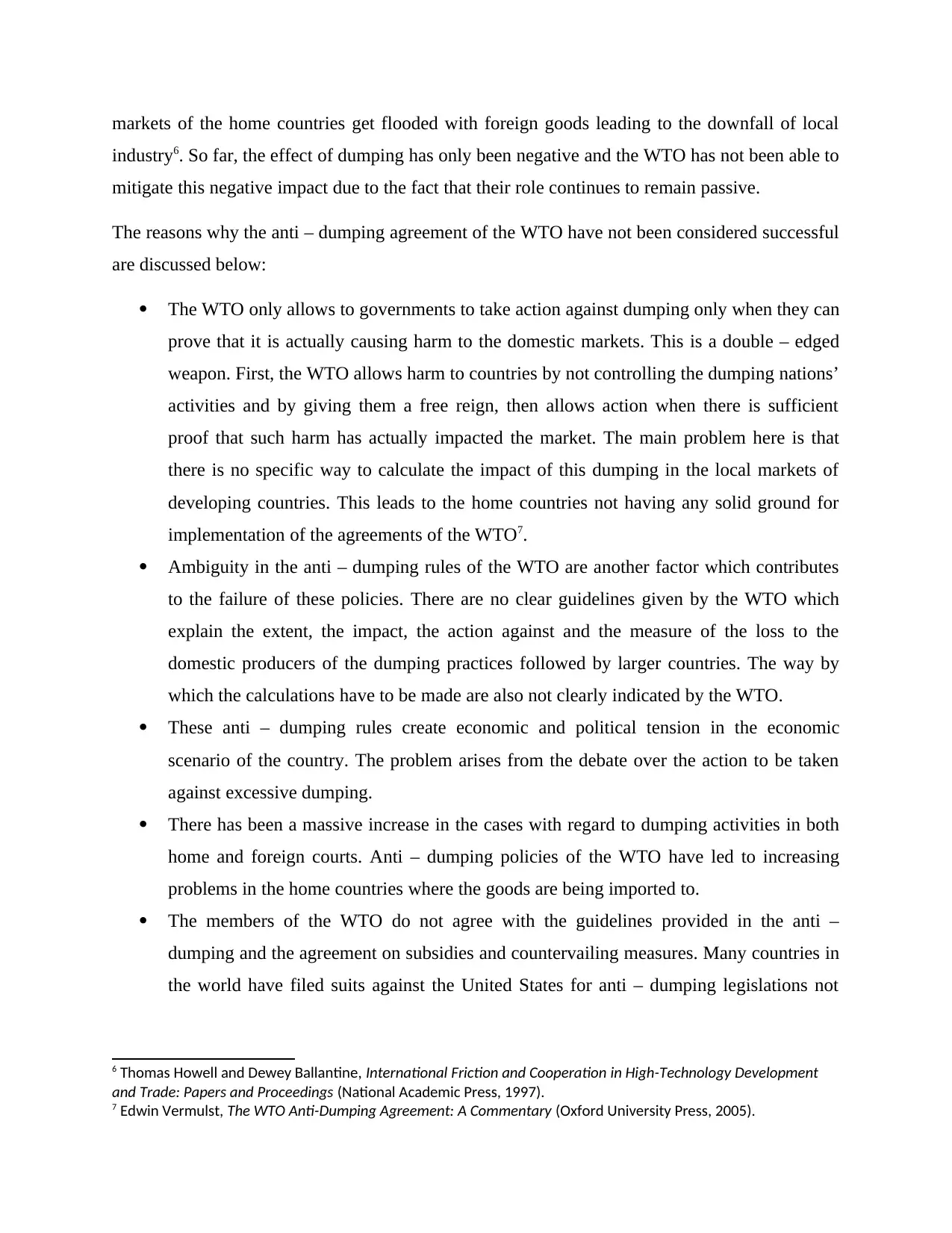
markets of the home countries get flooded with foreign goods leading to the downfall of local
industry6. So far, the effect of dumping has only been negative and the WTO has not been able to
mitigate this negative impact due to the fact that their role continues to remain passive.
The reasons why the anti – dumping agreement of the WTO have not been considered successful
are discussed below:
The WTO only allows to governments to take action against dumping only when they can
prove that it is actually causing harm to the domestic markets. This is a double – edged
weapon. First, the WTO allows harm to countries by not controlling the dumping nations’
activities and by giving them a free reign, then allows action when there is sufficient
proof that such harm has actually impacted the market. The main problem here is that
there is no specific way to calculate the impact of this dumping in the local markets of
developing countries. This leads to the home countries not having any solid ground for
implementation of the agreements of the WTO7.
Ambiguity in the anti – dumping rules of the WTO are another factor which contributes
to the failure of these policies. There are no clear guidelines given by the WTO which
explain the extent, the impact, the action against and the measure of the loss to the
domestic producers of the dumping practices followed by larger countries. The way by
which the calculations have to be made are also not clearly indicated by the WTO.
These anti – dumping rules create economic and political tension in the economic
scenario of the country. The problem arises from the debate over the action to be taken
against excessive dumping.
There has been a massive increase in the cases with regard to dumping activities in both
home and foreign courts. Anti – dumping policies of the WTO have led to increasing
problems in the home countries where the goods are being imported to.
The members of the WTO do not agree with the guidelines provided in the anti –
dumping and the agreement on subsidies and countervailing measures. Many countries in
the world have filed suits against the United States for anti – dumping legislations not
6 Thomas Howell and Dewey Ballantine, International Friction and Cooperation in High-Technology Development
and Trade: Papers and Proceedings (National Academic Press, 1997).
7 Edwin Vermulst, The WTO Anti-Dumping Agreement: A Commentary (Oxford University Press, 2005).
industry6. So far, the effect of dumping has only been negative and the WTO has not been able to
mitigate this negative impact due to the fact that their role continues to remain passive.
The reasons why the anti – dumping agreement of the WTO have not been considered successful
are discussed below:
The WTO only allows to governments to take action against dumping only when they can
prove that it is actually causing harm to the domestic markets. This is a double – edged
weapon. First, the WTO allows harm to countries by not controlling the dumping nations’
activities and by giving them a free reign, then allows action when there is sufficient
proof that such harm has actually impacted the market. The main problem here is that
there is no specific way to calculate the impact of this dumping in the local markets of
developing countries. This leads to the home countries not having any solid ground for
implementation of the agreements of the WTO7.
Ambiguity in the anti – dumping rules of the WTO are another factor which contributes
to the failure of these policies. There are no clear guidelines given by the WTO which
explain the extent, the impact, the action against and the measure of the loss to the
domestic producers of the dumping practices followed by larger countries. The way by
which the calculations have to be made are also not clearly indicated by the WTO.
These anti – dumping rules create economic and political tension in the economic
scenario of the country. The problem arises from the debate over the action to be taken
against excessive dumping.
There has been a massive increase in the cases with regard to dumping activities in both
home and foreign courts. Anti – dumping policies of the WTO have led to increasing
problems in the home countries where the goods are being imported to.
The members of the WTO do not agree with the guidelines provided in the anti –
dumping and the agreement on subsidies and countervailing measures. Many countries in
the world have filed suits against the United States for anti – dumping legislations not
6 Thomas Howell and Dewey Ballantine, International Friction and Cooperation in High-Technology Development
and Trade: Papers and Proceedings (National Academic Press, 1997).
7 Edwin Vermulst, The WTO Anti-Dumping Agreement: A Commentary (Oxford University Press, 2005).
Paraphrase This Document
Need a fresh take? Get an instant paraphrase of this document with our AI Paraphraser
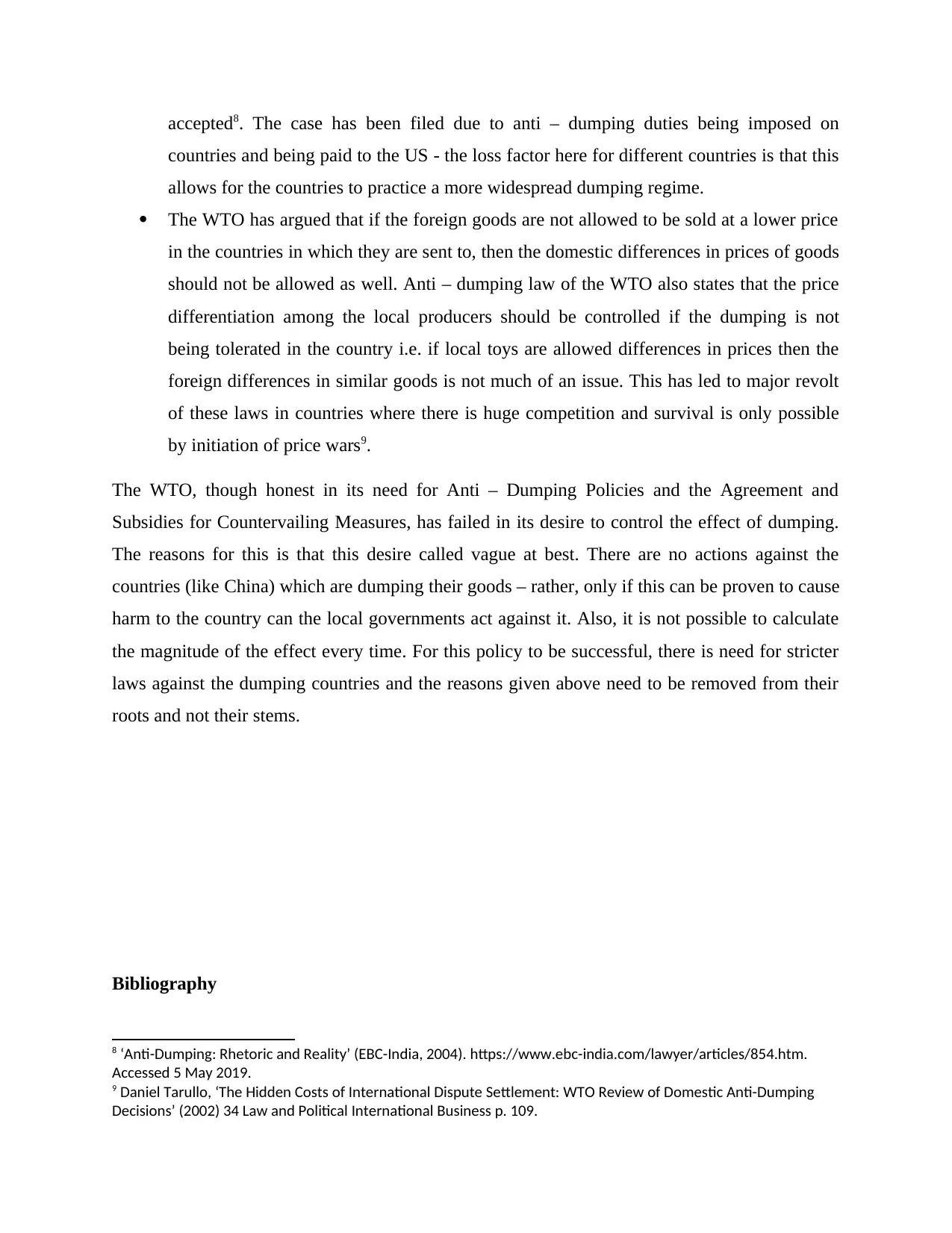
accepted8. The case has been filed due to anti – dumping duties being imposed on
countries and being paid to the US - the loss factor here for different countries is that this
allows for the countries to practice a more widespread dumping regime.
The WTO has argued that if the foreign goods are not allowed to be sold at a lower price
in the countries in which they are sent to, then the domestic differences in prices of goods
should not be allowed as well. Anti – dumping law of the WTO also states that the price
differentiation among the local producers should be controlled if the dumping is not
being tolerated in the country i.e. if local toys are allowed differences in prices then the
foreign differences in similar goods is not much of an issue. This has led to major revolt
of these laws in countries where there is huge competition and survival is only possible
by initiation of price wars9.
The WTO, though honest in its need for Anti – Dumping Policies and the Agreement and
Subsidies for Countervailing Measures, has failed in its desire to control the effect of dumping.
The reasons for this is that this desire called vague at best. There are no actions against the
countries (like China) which are dumping their goods – rather, only if this can be proven to cause
harm to the country can the local governments act against it. Also, it is not possible to calculate
the magnitude of the effect every time. For this policy to be successful, there is need for stricter
laws against the dumping countries and the reasons given above need to be removed from their
roots and not their stems.
Bibliography
8 ‘Anti-Dumping: Rhetoric and Reality’ (EBC-India, 2004). https://www.ebc-india.com/lawyer/articles/854.htm.
Accessed 5 May 2019.
9 Daniel Tarullo, ‘The Hidden Costs of International Dispute Settlement: WTO Review of Domestic Anti-Dumping
Decisions’ (2002) 34 Law and Political International Business p. 109.
countries and being paid to the US - the loss factor here for different countries is that this
allows for the countries to practice a more widespread dumping regime.
The WTO has argued that if the foreign goods are not allowed to be sold at a lower price
in the countries in which they are sent to, then the domestic differences in prices of goods
should not be allowed as well. Anti – dumping law of the WTO also states that the price
differentiation among the local producers should be controlled if the dumping is not
being tolerated in the country i.e. if local toys are allowed differences in prices then the
foreign differences in similar goods is not much of an issue. This has led to major revolt
of these laws in countries where there is huge competition and survival is only possible
by initiation of price wars9.
The WTO, though honest in its need for Anti – Dumping Policies and the Agreement and
Subsidies for Countervailing Measures, has failed in its desire to control the effect of dumping.
The reasons for this is that this desire called vague at best. There are no actions against the
countries (like China) which are dumping their goods – rather, only if this can be proven to cause
harm to the country can the local governments act against it. Also, it is not possible to calculate
the magnitude of the effect every time. For this policy to be successful, there is need for stricter
laws against the dumping countries and the reasons given above need to be removed from their
roots and not their stems.
Bibliography
8 ‘Anti-Dumping: Rhetoric and Reality’ (EBC-India, 2004). https://www.ebc-india.com/lawyer/articles/854.htm.
Accessed 5 May 2019.
9 Daniel Tarullo, ‘The Hidden Costs of International Dispute Settlement: WTO Review of Domestic Anti-Dumping
Decisions’ (2002) 34 Law and Political International Business p. 109.
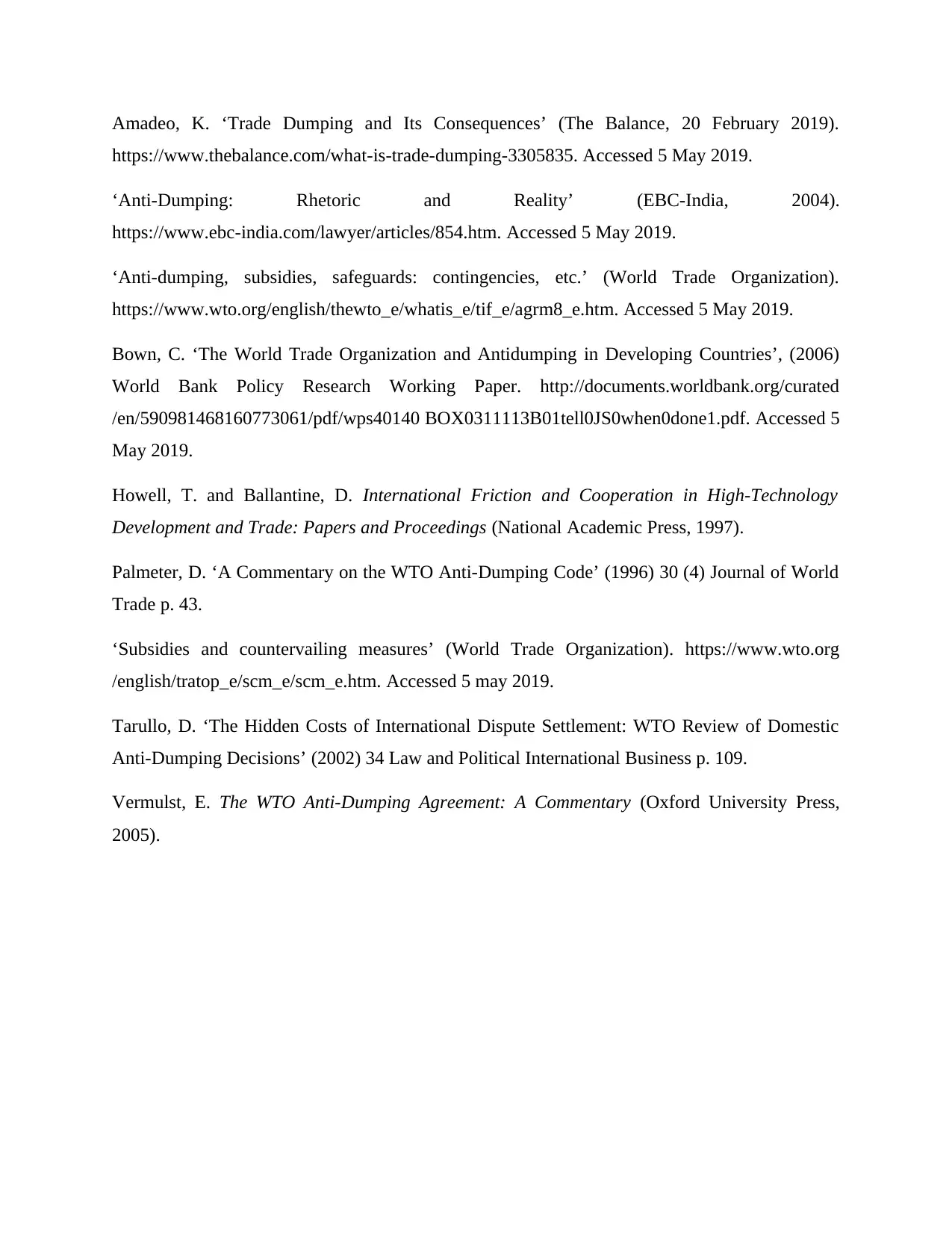
Amadeo, K. ‘Trade Dumping and Its Consequences’ (The Balance, 20 February 2019).
https://www.thebalance.com/what-is-trade-dumping-3305835. Accessed 5 May 2019.
‘Anti-Dumping: Rhetoric and Reality’ (EBC-India, 2004).
https://www.ebc-india.com/lawyer/articles/854.htm. Accessed 5 May 2019.
‘Anti-dumping, subsidies, safeguards: contingencies, etc.’ (World Trade Organization).
https://www.wto.org/english/thewto_e/whatis_e/tif_e/agrm8_e.htm. Accessed 5 May 2019.
Bown, C. ‘The World Trade Organization and Antidumping in Developing Countries’, (2006)
World Bank Policy Research Working Paper. http://documents.worldbank.org/curated
/en/590981468160773061/pdf/wps40140 BOX0311113B01tell0JS0when0done1.pdf. Accessed 5
May 2019.
Howell, T. and Ballantine, D. International Friction and Cooperation in High-Technology
Development and Trade: Papers and Proceedings (National Academic Press, 1997).
Palmeter, D. ‘A Commentary on the WTO Anti-Dumping Code’ (1996) 30 (4) Journal of World
Trade p. 43.
‘Subsidies and countervailing measures’ (World Trade Organization). https://www.wto.org
/english/tratop_e/scm_e/scm_e.htm. Accessed 5 may 2019.
Tarullo, D. ‘The Hidden Costs of International Dispute Settlement: WTO Review of Domestic
Anti-Dumping Decisions’ (2002) 34 Law and Political International Business p. 109.
Vermulst, E. The WTO Anti-Dumping Agreement: A Commentary (Oxford University Press,
2005).
https://www.thebalance.com/what-is-trade-dumping-3305835. Accessed 5 May 2019.
‘Anti-Dumping: Rhetoric and Reality’ (EBC-India, 2004).
https://www.ebc-india.com/lawyer/articles/854.htm. Accessed 5 May 2019.
‘Anti-dumping, subsidies, safeguards: contingencies, etc.’ (World Trade Organization).
https://www.wto.org/english/thewto_e/whatis_e/tif_e/agrm8_e.htm. Accessed 5 May 2019.
Bown, C. ‘The World Trade Organization and Antidumping in Developing Countries’, (2006)
World Bank Policy Research Working Paper. http://documents.worldbank.org/curated
/en/590981468160773061/pdf/wps40140 BOX0311113B01tell0JS0when0done1.pdf. Accessed 5
May 2019.
Howell, T. and Ballantine, D. International Friction and Cooperation in High-Technology
Development and Trade: Papers and Proceedings (National Academic Press, 1997).
Palmeter, D. ‘A Commentary on the WTO Anti-Dumping Code’ (1996) 30 (4) Journal of World
Trade p. 43.
‘Subsidies and countervailing measures’ (World Trade Organization). https://www.wto.org
/english/tratop_e/scm_e/scm_e.htm. Accessed 5 may 2019.
Tarullo, D. ‘The Hidden Costs of International Dispute Settlement: WTO Review of Domestic
Anti-Dumping Decisions’ (2002) 34 Law and Political International Business p. 109.
Vermulst, E. The WTO Anti-Dumping Agreement: A Commentary (Oxford University Press,
2005).
⊘ This is a preview!⊘
Do you want full access?
Subscribe today to unlock all pages.

Trusted by 1+ million students worldwide
1 out of 6
Related Documents
Your All-in-One AI-Powered Toolkit for Academic Success.
+13062052269
info@desklib.com
Available 24*7 on WhatsApp / Email
![[object Object]](/_next/static/media/star-bottom.7253800d.svg)
Unlock your academic potential
Copyright © 2020–2025 A2Z Services. All Rights Reserved. Developed and managed by ZUCOL.





